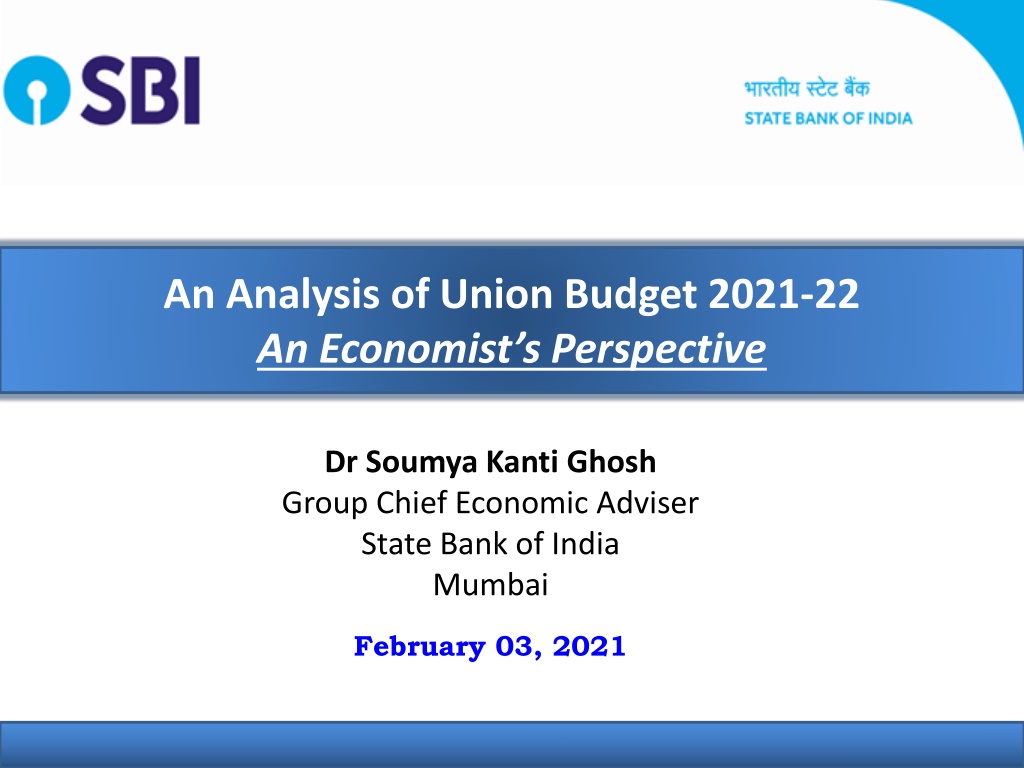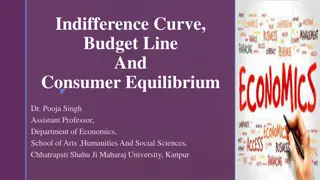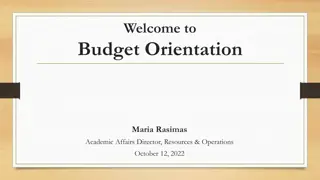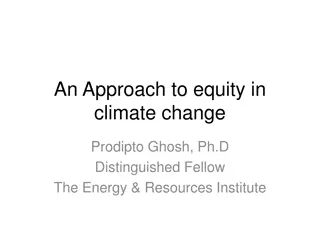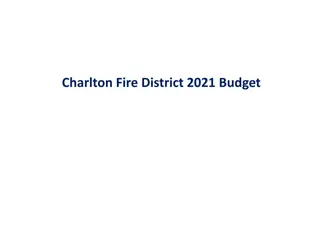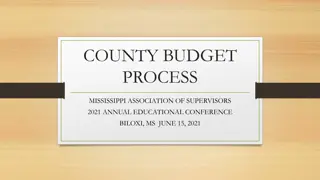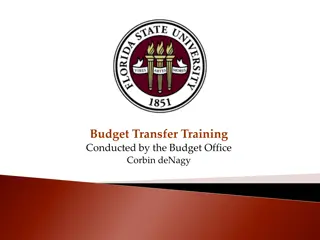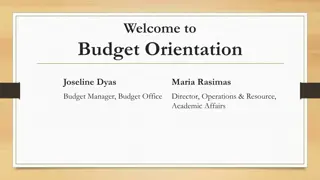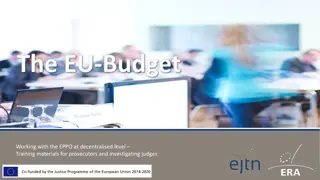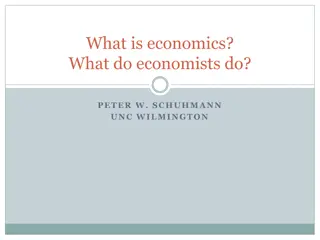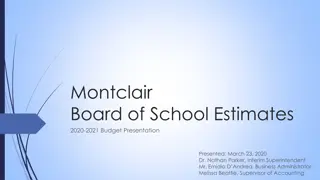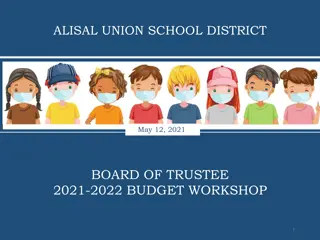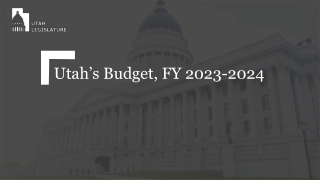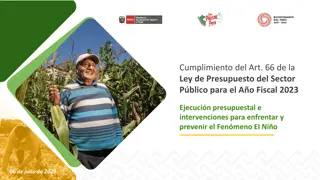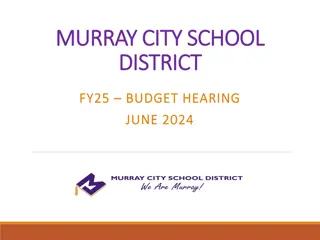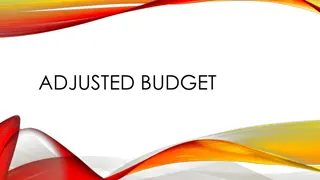Analysis of Union Budget 2021-22: Economist's Perspective by Dr. Soumya Kanti Ghosh
The analysis provides insights into the fiscal arithmetic of FY21 and projections for FY22, including capital expenditure growth, revenue receipts, non-tax revenue, disinvestment targets, and measures for financial consolidation. It highlights the shift towards greater transparency in finances and the financing of fiscal deficit through small savings.
Download Presentation

Please find below an Image/Link to download the presentation.
The content on the website is provided AS IS for your information and personal use only. It may not be sold, licensed, or shared on other websites without obtaining consent from the author. Download presentation by click this link. If you encounter any issues during the download, it is possible that the publisher has removed the file from their server.
E N D
Presentation Transcript
An Analysis of Union Budget 2021-22 An Economist s Perspective Dr Soumya Kanti Ghosh Group Chief Economic Adviser State Bank of India Mumbai February 03, 2021
Fiscal Arithmetic of FY21 In FY22 Government has projected capital expenditure with real growth of over 21%, while revenue expenditure growth is -6.5%, which is growth positive Revenue receipts are also projected at more than 10% in real terms The genesis of fiscal deficit for FY21 in incremental terms indicates that there is a revenue loss of Rs 8.7 lakh crore (including Centre) along with expenditure increase of Rs 4.12 lakh crore. This leads to increase of fiscal deficit from Rs 8.0 lakh crore to Rs 18.5 lakh crore in FY21 Almost 75% of expenditure increase in FY21 is due to increase in food subsidy (Rs 3.07 lakh crore) Corporation tax, Income tax will recover next year to grow around 22% each Even Customs are expected to pick up in FY22 2 Economic Research Department
Non-Tax Revenue & Disinvestment Government estimates the non-tax revenue to grow at 15.3% to Rs 2.43 lakh crore, from the revised estimate of Rs 2.10 lakh crore. The Government has estimated receipts under Other Communication Services mainly relate to the license fees from telecom operators and receipts on account of spectrum usage charges of Rs 53,986 crore in FY22 from last year revised estimate of Rs 37,737 crore. It seems Government is expecting around Rs 20,000 crore from 5G spectrum actions Disinvestment Target vs. Actual (in Rs crore) Government has set a target of Rs 1.75 lakh Budget Estimate 69,500 Revised Estimate 25,312 Year Actual crore of disinvestment for FY22 on back of FY16 42,132 FY17 56,500 45,500 34,939 LIC IPO and the pending/remaining FY18 72,500 1,00,045 1,00,057 disinvestments of FY21. The disinvestment FY19 80,000 80,000 94,727 proceeds from LIC and other financial FY20 1,05,000 65,000 50,304 FY21 2,10,000 32,000 - institutions is pegged at Rs 1 lakh crore FY22 1,75,000 - - Source: Union Budget Documents, CGA, SBI Research 3 Economic Research Department
Consolidation of Finances: Move towards greater transparency Outstanding liabilities of FCI financed through NSSF funds as on 1 April 2020 was Rs 2.54 lakh crore. As per revised estimates, in FY21 the Government made net repayments of Rs 1.36 lakh crore. Thus of this Rs 3 lakh crore increase in food subsidy bill, an amount of Rs 1.58 lakh crore ( including intt payment) seems to have shifted from off-balance sheet entry to fiscal estimates Thus if we take the amount of Rs 1.58 lakh crore shifted from off-balance sheet to food subsidy bill and reduce from the revised estimate of fiscal deficit, then in effect fiscal deficit would be around 8.7% of GDP instead of 9.5% of GDP Also, of the additional expenditure of Rs 4.1 lakh crore (Rs 3.8 lakh crore of Revenue Expenditure and Rs 0.3 lakh crore of Capital Expenditure) the actual incremental spending, after removing the off balance sheet amount shifted to food subsidy bill, is still Rs 2.5 lakh crore 4 Economic Research Department
Financing of Fiscal Deficit Huge reliance on small savings In FY22, 26% of fiscal deficit is expected to be met through issuance of securities against small savings This increased reliance on small savings, in turn, would make it difficult for the Government to cut small savings interest rate and thus bank deposit rates might be impacted The Gross Government Borrowing is Budgeted at Rs 12.1 lakh crore against revised Rs 12.8 lakh crore in FY21, while net borrowing after considering of repayment (Rs 2.8 lakh crore) is pegged at Rs 9.2 lakh crore compared to revised estimate of Rs 10.5 lakh crore in FY21 5 Economic Research Department
Infrastructure investment gets a boost: Positive moves for Banks National Monetization Pipeline (NMP) will be launched to monetize Public Infrastructure of brownfield category and a monetization dashboard will be created for information flow (on monetization tracking) to investors Monetizable assets : (i) NHAI Operational Toll Roads (ii) Transmission Assets of PGCIL (iii) Oil and Gas Pipelines of GAIL, IOCL and HPCL (iv) AAI Airports in Tier II and III cities, (v) Other Railway Infrastructure Assets (vi) Warehousing Assets of CPSEs such as Central Warehousing Corporation and NAFED among others and (vii) Sports Stadiums FM proposed to relax some of these conditions relating to prohibition on private funding, restriction on commercial activities, and direct investment in infrastructure. In order to allow funding of infrastructure by issue of Zero Coupon Bonds, FM proposed to make notified Infrastructure Debt Funds eligible to raise funds by issuing tax efficient Zero Coupon Bonds. 6 Economic Research Department
Indias Health Infrastructure (1) Taking a holistic approach to Health, Budget focusses on strengthening three areas: Preventive, Curative, and Wellbeing. The Budget outlay for Health and Wellbeing at Rs 2.24 lakh crore is 137% more than the BE of FY21 (Rs 94,452 crore). This expenditure is 1.8% of GDP Provision of Rs 35,000 crore made for Covid-19 vaccine 7 Economic Research Department
MSME & Start-ups To further facilitate credit flow under the scheme of Stand-Up India for SCs, STs, and women, the Finance Minister proposed to reduce the margin money requirement from 25% to 15%, and to also include loans for activities allied to agriculture. Budget has provided Rs 15,700 crore to MSMEs In order to incentivise setting-up of more start-ups in the country, it is proposed to extend the eligibility period to claim tax holiday for the start-ups by one more year to 31st March 2022 8 Economic Research Department
Steps to Agri Support Agricultural credit target enhanced to Rs 16.5 lakh crore in FY22 33% increase in Rural Infrastructure Development Fund from Rs 30,000 crore to Rs 40,000 crore Micro Irrigation Fund doubled by another Rs 5,000 crore Increase the scope of Operation Green Scheme that is presently applicable to tomatoes, onions, and potatoes (TOPS), to be enlarged to include 22 perishable products Integrate 1,000 more mandis with e-NAM to bring transparency and competitiveness. Currently top 5 states accounted for 60% of total mandis. APMCs to get access to Agriculture Infrastructure Fund for augmenting their infrastructure facilities 5 major fishing harbours Kochi, Chennai, Visakhapatnam, Paradip, and Petuaghat will be developed as hubs of economic activity Multipurpose Seaweed Park to be established in Tamil Nadu 9 Economic Research Department
Tax Proposals Proposed that Sr. citizens (above 75) earning only pension and interest income from deposits would not be required to file ITR. This will reduce the compliance burden on senior citizens; however, the paying Bank will deduct the necessary tax on their income EPF interest income above Rs 2.5 lakh will be taxable, which will only apply to the employee s contribution and not that of the employer. However, the proposal will only affect a creamy layer of salaried employees, as the Rs 2.5 lakh annual threshold means a person contributing up to Rs 20,833 a month to PF (basic salary of Rs 1.73 lakh a month) Agri Infrastructure and Development Cess on several items including fuel and liquor was announced but there would be no additional burden on the consumer overall Giving a fillip to the buyers of affordable houses, Government has extended the time period of taking loans to buy such houses by one year i.e. from March 31, 2021 to March 31, 2022 to avail additional tax benefits of Rs 1.5 lakh u/s 80EEA of the Income Tax Act. The benefit is over and above the tax benefit of Rs 2 lakh available u/s 24(B) of the Income Tax Act on interest on Housing Loan on both self-occupied and rented properties 10 Economic Research Department
11 Economic Research Department
